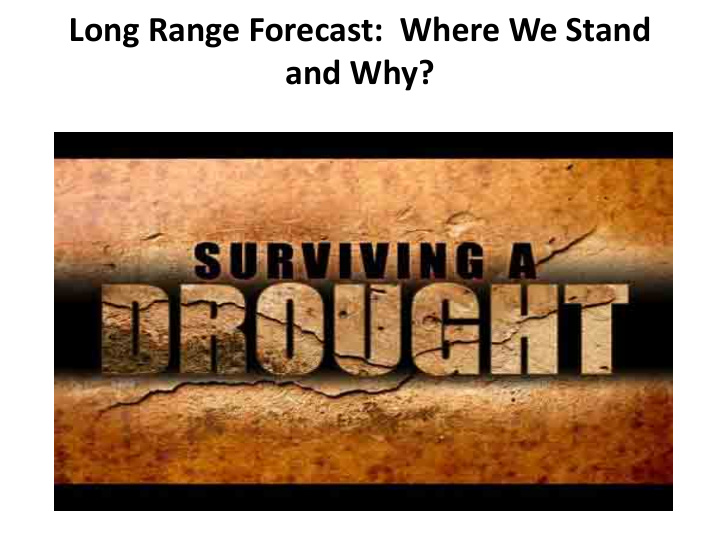



Long Range Forecast: Where We Stand and Why?
Who’s Getting Rain or Snow? The data cutoff for Drought Monitor maps is Tuesday at 7 a.m. Eastern Standard Time. The maps, which are based on analysis of the data, are released each Thursday at 8:30 a.m. Eastern Time.
Very Long Way to Go… The data cutoff for Drought Monitor maps is Tuesday at 7 a.m. Eastern Standard Time. The maps, which are based on analysis of the data, are released each Thursday at 8:30 a.m. Eastern Time.
Long Range Forecast: El Nino, La Nina, Other?
El Nino vs La Nina Weather Patterns
Dec. 27 th Sea Surface Temperature Anomalies
SST Outlook: NCEP CFS.v2 Forecast Issued January 28 th 2012 The CFS.v2 ensemble mean (black dashed line) predicts below-average SSTs through spring of 2013. CFS.v1 has been discontinued.
EURO 3.4 SST Anomaly Forecast • Goodbye
POAMA Model Forecast • Goodbye
Long Range Forecast: Not Just About El Nino or La Nina…
Other Oscillations… • Madden Julian Oscillation (Very Important) • Arctic Oscillation • Pacific-North American Oscillation • North Atlantic Oscillation • Eastern Pacific Oscillation • Western Pacific Oscillation • Solar Cycle • All contribute in large ways to controlling our weather and climate. • http://www.cpc.ncep.noaa.gov/products/precip/CWlink/d aily_ao_index/teleconnections.shtml
Madden-Julian Oscillation • Overall, the MJO tends to be most active during ENSO neutral or “La Nada” years. • It is often absent during moderate-to- strong El Niño and La Niña events. • Can happen during La Nina years, but is quite rare… • Strong MJO activity usually precedes the development of an El Nino by 6-12 months. • Strong MJO activity CAN result in bringing some good moisture producing storms to the western US, due to tropical connection.
Current MJO Cycle Strongest cycle we have seen in months, but continues to weaken/slow eastward movement. When the MJO enters eastern region 7 and western region 8, it usually enhances storm activity for the western US. This can in turn produce moisture chances for Colorado and the surrounding states. The good snow in the southwest mountains of Colorado from Friday January 25 th – 28 th , is a classic example of this. THIS CURRENT CYCLE OF NO HELP TO EASTERN COLORADO…
Tracking The MJO… Recent Daily Time Series Very Inactive & Very Dry…
Pacific Decadal Oscillation & Atlantic Multidecadal Oscillation {Commonly Referred to as the PDO and AMO} Reliving The 50s…
Pertaining to Drought Frequency Blue = Lower Frequency Red = Higher Frequency Current Phase Next Phase
Long Range Forecast: Model Forecasts
CFSv2 Precipitation Prediction • THE LAST 60+ YEARS
CFSv2 Precipitation Prediction • THE LAST 60+ YEARS
CFSv2 Precipitation Prediction • THE LAST 60+ YEARS
Climate Prediction Center Outlook March - May • THE LAST 60+ YEARS
Long Range Forecast: My Regional Breakdown
February and March • Regions 1,3, &4: Continued mainly dry and warmer than normal. Areas north of I-70 best potential for some moisture , but likely not enough to help with drought… • Regions 2 & 5: • Western half of state will get better moisture, but still drier than normal. San Luis Valley will be mainly dry .
April and May • Regions 1,3, &4: April and May both look much drier and much warmer than normal. Increase in wind will only make matters worse. North of I-70 still best shot of some moisture. • Regions 2 & 5: • Drier and warmer than normal. Likely accelerating melt of snowpack ala 2012.
June and July • Regions 1,3, &4: June continue to looks dry and HOT. July may offer some relief for western parts of region 4 and 1. Monsoon??? • Regions 2 & 5: • Will do better as whatever monsoon we see starts to crank up, and focus on western part of state. Initial dry lightning a concern for fires…July better.
August and September • Regions 1,3, &4: August usually CO’s wettest month. Again, western region 1&4 will do better than eastern region1,3, & 4. Plan dry, as monsoon greatly in question. • Regions 2 & 5: • Monsoon moisture looks to set up best for region 2&5, especially for August. I would plan accordingly…
October, November, and December • Regions 1,3, &4: Going with drier and warmer than normal until something changes. I see no big change in El Nino/La Nina phase. Drought would continue to hang on… • Regions 2 & 5: • Monsoon will help and seasonal transition will offer warmer than normal temps and near normal precip.
My Thoughts… • While technically not in a true La Nina, the pattern sure resembles La Nina… • Models are in pretty good agreement in continuing the regional drought. • Rest of winter and spring looks very dry to me especially for eastern half of the state… • Drought feeds on drought…I cannot say this enough when talking about its driving force. • Spring/seasonal change will offer some potential relief…too far north? • Guard against drought until we start getting REGULAR moisture. No case right now for transition to strong La Nina or El Nino.
THANK YOU ! • brianbledsoewx@gmail.com • 719-661-1364 • Call or E-Mail Anytime • @brianbledsoewx on Twitter • BrianBledsoeWx, LLC on Facebook
Recommend
More recommend